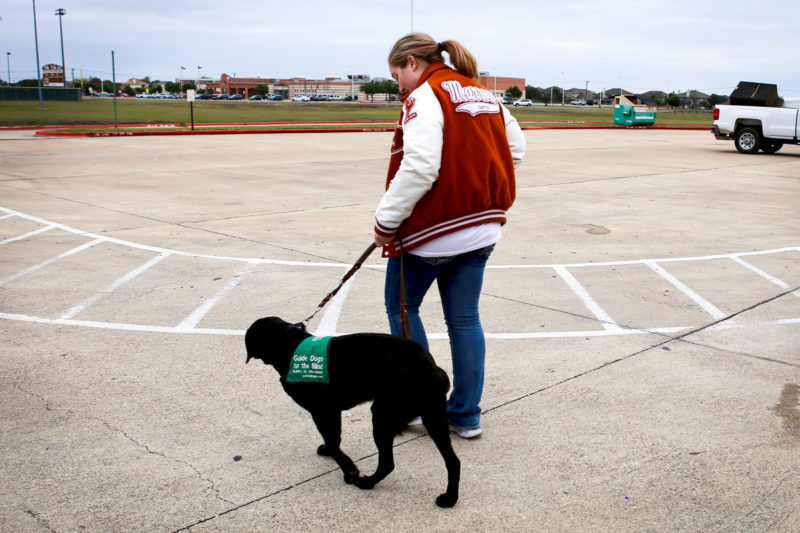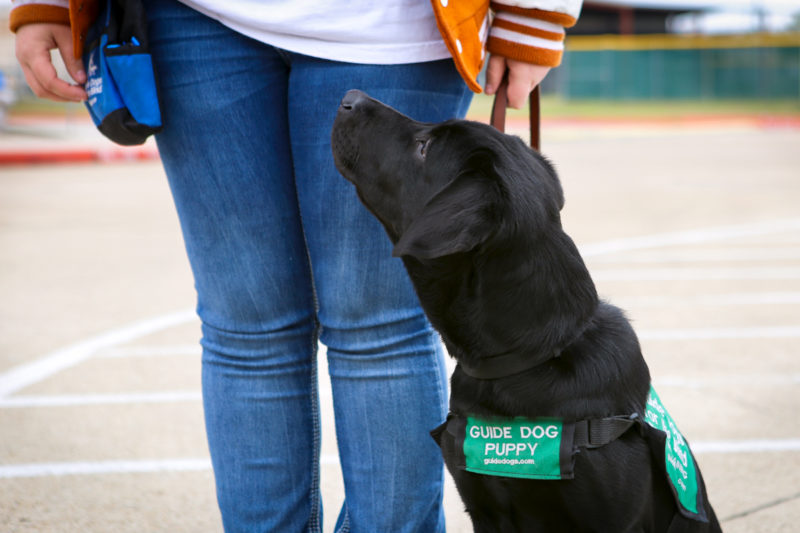With Good Boys and Girls, Hutto Students Learn to Train and Raise Guide Dogs
By Andrea Cos
Reporting Texas

Lora Marrow, 17, walks Hermosa outside Hutto High School on Nov. 13, 2018. Katherine Corley/Reporting Texas.
Izabelle Harris walked down the hallways of Hutto High School, weaving through students on her way to a classroom. Beside her strolled a 5-month-old yellow Labrador Retriever.
The puppy, named Zephyr, calmly bypassed a group of rowdy teenagers.
“Good girl,” Harris said.
No one was fazed by the presence of Zephyr. Everyone at school knew Harris as one of the puppy raisers. And they knew what Zephyr’s bright green vest meant.
In the spring of 2017, agricultural science teacher Natalie Nielsen started the program to train service dogs for the visually impaired. The program teaches the puppies to not jump on people, walk with a loose leash and turn away if someone tries to pet them. It is the first of its kind in the Austin area, and it is one of only four such programs in the state.

Natalie Nielsen gives Hermosa a treat behind her desk. Nielsen started the guide dog training program and has been training dogs for three years. Katherine Corley/Reporting Texas.
Nielsen wanted more for her students than simply raising livestock animals. She wanted to teach them responsibility in a way that would help impact someone else’s life.
Along with Harris, she works with three other students from her agricultural science classes. There’s Mia Rafanan, a sophomore with her puppy Tashi, Lora Marrow, a senior who puppy-sits Luan, and Rhyleeh Stanley, a sophomore who helps train Zinfendal.
Hutto High School partnered with Guide Dogs for the Blind, a training facility in San Rafael, California. As part of the program, the puppy raisers received an 8-week old Lab to work with for about a year. The puppy-sitters, in turn, are tasked with helping take care of the dogs whenever their raisers can’t.
“Just being able to help someone, to play a role in influencing someone’s life for the better, is what drew us to the program,” said Stanley, the sophomore puppy-sitter.
As members of Future Farmers of America, a youth organization that supports agricultural education, they were traditionally required to raise some type of farm animal. But Nielsen’s program opened the doors for these girls to raise or puppy-sit dogs for the visually impaired.
Their job is to socialize the dogs, house-train them, teach them basic commands and help them learn to behave in public.
The puppies go everywhere with Nielsen and the students — from the school bus to the crowded hallways to all their classes. And at the end of the school day, the animals go home with their trainers.
“High school is pretty much the perfect environment,” Nielsen said.
It’s especially important to teach the puppies to stay focused and ambivalent to the oftentimes chaotic stimuli, she said, especially considering these puppies are training to be someone’s eyes.
“Just seeing my dog mature has been an incredible experience,” Nielsen said. “Seeing that dog grow is like seeing how they’re going to be for their owners in the future, and being a part of that is truly humbling.”
Puppy raisers play a crucial role in the effort to change the lives of the blind and visually impaired, said Jamie Massey, the director of training for Guide Dogs of Texas. Their role could make or break the success of the puppy they’re raising.
It takes many volunteers to help a single puppy become a guide dog, she said. And this portion of the dog’s journey is only the beginning. After their year is up, the dogs will head back to a main campus to become official guide dogs. There, they will be trained to lead a person in a straight line, to stop for all changes in elevation, to stop for overhead obstacles and to avoid obstacles in their path.
The Hutto High School program is on its second set of dogs. In April, the animals will head back to the main campus in California. There, they will have to pass five tests to become official guide dogs. The school will then receive a new set of puppies and the process will start all over again.

Hermosa, a 9-month-old Labrador Retriever, receives a command from her trainer Lora Marrow. Trainers teach the guide dogs various commands – such as sit, stay and lie down – and reinforce learning with treats. Katherine Corley/Reporting Texas.
If their puppies pass their tests, Harris and the other high school trainers would travel to California for the graduation ceremony. There, they would get the chance to hand over the puppies they love and raised to their future owners.
“Zephyr’s a piece of me, but I’m raising her for someone who needs her,” said Harris, the sophomore puppy raiser. “And I can’t wait for all the happiness she’ll bring to her future owner.”
The Hutto program has sent three dogs to the campus in California. One of their puppies has already been placed. The other two have passed their tests and are waiting placement.
This is no small feat. Only 44 percent of the dogs that go into the training campuses actually graduate to become official guide dogs.
After almost two years of running the program, one of Nielsen’s biggest joys is seeing her students grow. Raising and training the dogs has made them more conscientious, she said. They’ve learned responsibility, while at the same time, they’ve taught their peers how to react and behave around service animals.
“Being a part of this program has taught us so much,” said Marrow, the senior puppy-sitter. “We have to be responsible not only for ourselves but for our dogs as well.”
Rafanan, the sophomore puppy raiser, agreed.
“We’re raising these puppies’ during a crucial development point,” she said. “And the way we train them could really make a difference in someone’s life.”
And making a difference is what it’s all about for them.
“We want to continue to grow our program with the right students, and we want students that are in it for the right reasons,” Nielsen said. “We want students who want to raise a dog to make a difference.”